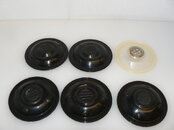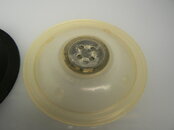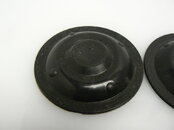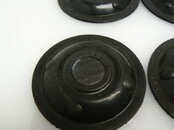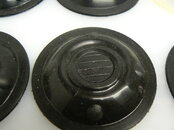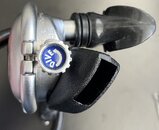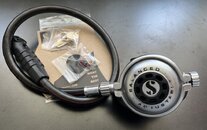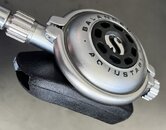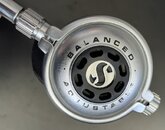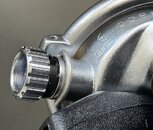Interesting, I have the schematics (1995) for yours, shows the diaphragm with the four bumps. Trying to find out the history of mine and the schematics.Yup, I can take closer pics.
I also have a G500 with this style of chunkier diaphragm.
You are using an out of date browser. It may not display this or other websites correctly.
You should upgrade or use an alternative browser.
You should upgrade or use an alternative browser.
The Grail
- Thread starter Nemrod
- Start date
Please register or login
Welcome to ScubaBoard, the world's largest scuba diving community. Registration is not required to read the forums, but we encourage you to join. Joining has its benefits and enables you to participate in the discussions.
Benefits of registering include
- Ability to post and comment on topics and discussions.
- A Free photo gallery to share your dive photos with the world.
- You can make this box go away
Geo7
Contributor
After some more thinking, here is a wild guess about what the bumps could be for: Maybe to achieve some clearance between the outer rubber cover and the diaphragm itself? Any adhesive force between those two planes could impede diaphram movement. That would explain why no other model has the bumps.
Regarding the adjustment range limiter (the black ring on the adjuster knob): Maybe the designers felt that the traditional range allows inexperienced users to put too much pressure on the seat, leading to seats wearing out early? The reason for this speculation is that on the Atomic the adjusters allow for a narrow adjustment range. And the lead designers appear to be the same...
Regarding the adjustment range limiter (the black ring on the adjuster knob): Maybe the designers felt that the traditional range allows inexperienced users to put too much pressure on the seat, leading to seats wearing out early? The reason for this speculation is that on the Atomic the adjusters allow for a narrow adjustment range. And the lead designers appear to be the same...
axxel57
Contributor
I guess that the reason for that design was something else, because the '96 BA 156 model was not the only 2nd which experimented with those particular diaphragms.After some more thinking, here is a wild guess about what the bumps could be for: Maybe to achieve some clearance between the outer rubber cover and the diaphragm itself? Any adhesive force between those two planes could impede diaphram movement. That would explain why no other model has the bumps.
Regarding the adjustment range limiter (the black ring on the adjuster knob): Maybe the designers felt that the traditional range allows inexperienced users to put too much pressure on the seat, leading to seats wearing out early? The reason for this speculation is that on the Atomic the adjusters allow for a narrow adjustment range. And the lead designers appear to be the same...
The same diaphragms were used in the M50 2nds which came on the market that year, and their diaphrgm cover was very different than the BAs.
In '97 they modified the diaphragms, which were built ( smaller bumps) in the G250s, at least in the special models of that year.
I guess they never showed up in the US as new, and after only two seasons they were not used anymore.
And also quite sure was the adjustment range limiter a caution against divers with nervous fingers, I wouldn't know what for else that could have been installed.
Attachments
As they get older, the diaphragm cover does get tacky.
Geo7
Contributor
Wow, thanks! Now I am even more curious about the membrane. To reduce flutter that the high performance of the S-Wing poppet can deliver? (just fishing in the dark here)...I guess that the reason for that design was something else, because the '96 BA 156 model was not the only 2nd which experimented with those particular diaphragms.
The same diaphragms were used in the M50 2nds which came on the market that year, and their diaphrgm cover was very different than the BAs.
In '97 they modified the diaphragms, which were built ( smaller bumps) in the G250s, at least in the special models of that year.
I guess they never showed up in the US as new, and after only two seasons they were not used anymore.
And also quite sure was the adjustment range limiter a caution against divers with nervous fingers, I wouldn't know what for else that could have been installed.
Geo7
Contributor
One aesthetic preference (or authenticity) question: I might list my 156CE for sale soon as I fully switched to Ti Atomics.
However, I thought it is a good idea to put a satin matte chrome front cover on a satin matte chrome body for consistency. Correct or am I messing up the authenticity? Do you think people will prefer the way it came with a shiny polished front cover on a satin matte body? And why did Scubapro mix the appearance like that in the first place?
However, I thought it is a good idea to put a satin matte chrome front cover on a satin matte chrome body for consistency. Correct or am I messing up the authenticity? Do you think people will prefer the way it came with a shiny polished front cover on a satin matte body? And why did Scubapro mix the appearance like that in the first place?
If it’s original and interesting. Any pictures?One aesthetic preference (or authenticity) question: I might list my 156CE for sale soon as I fully switched to Ti Atomics.
However, I thought it is a good idea to put a satin matte chrome front cover on a satin matte chrome body for consistency. Correct or am I messing up the authenticity? Do you think people will prefer the way it came with a shiny polished front cover on a satin matte body? And why did Scubapro mix the appearance like that in the first place?
Geo7
Contributor
I just think these regs look better in all matte or all polished. Original OEM parts yes, but I think the 156CE was delivered with the polished front on a matte body (like yours).
Actually I always bothered why the production of some editions of Scubapro 1st stages swithed between polished and matte...
Actually I always bothered why the production of some editions of Scubapro 1st stages swithed between polished and matte...
Attachments
Similar threads
- Replies
- 5
- Views
- 730



